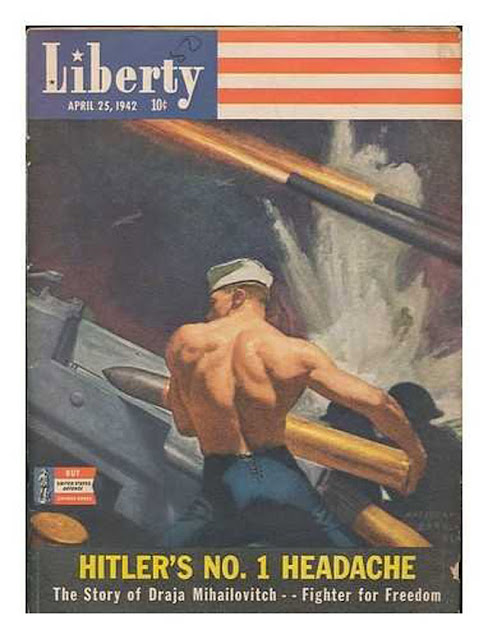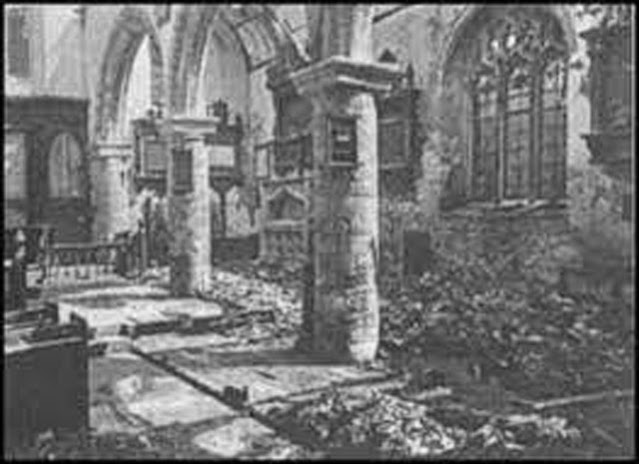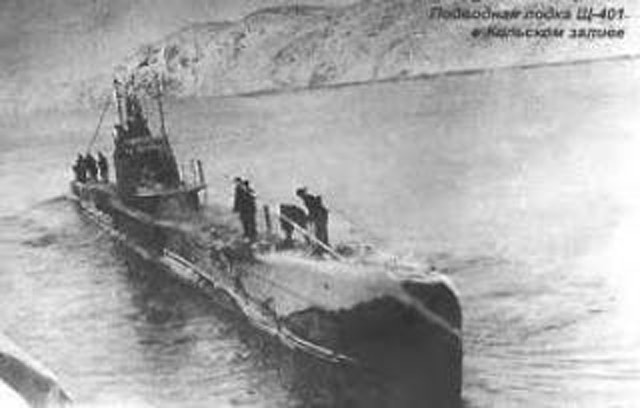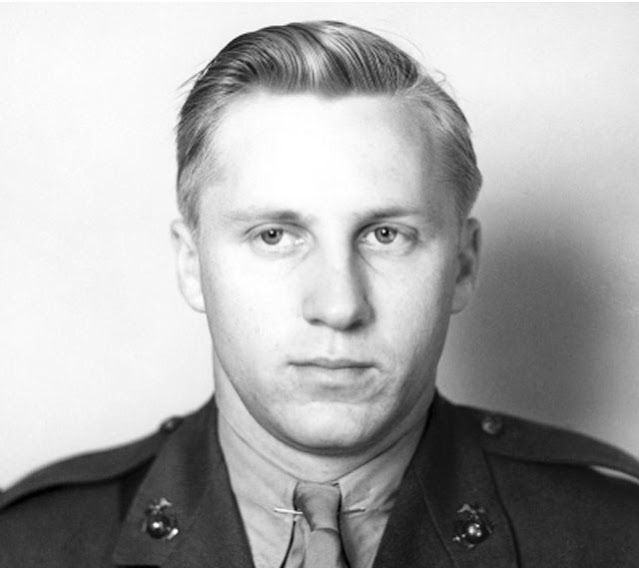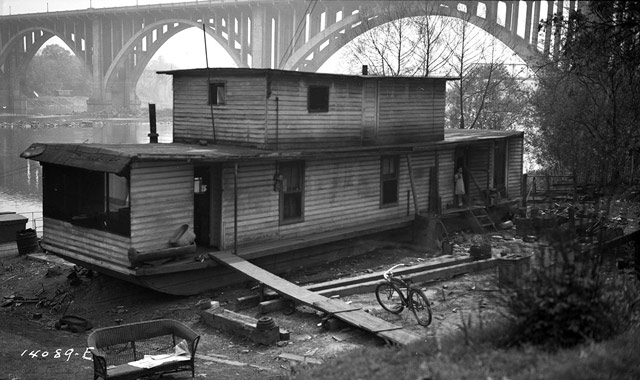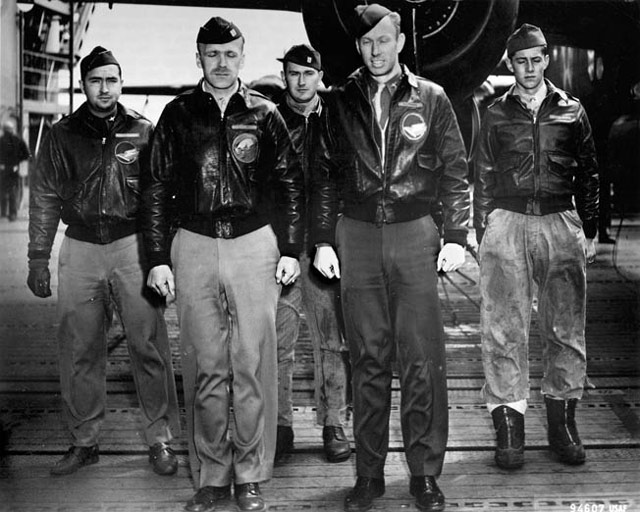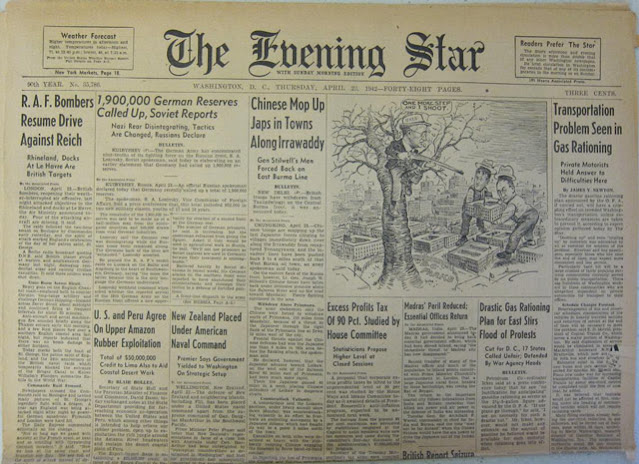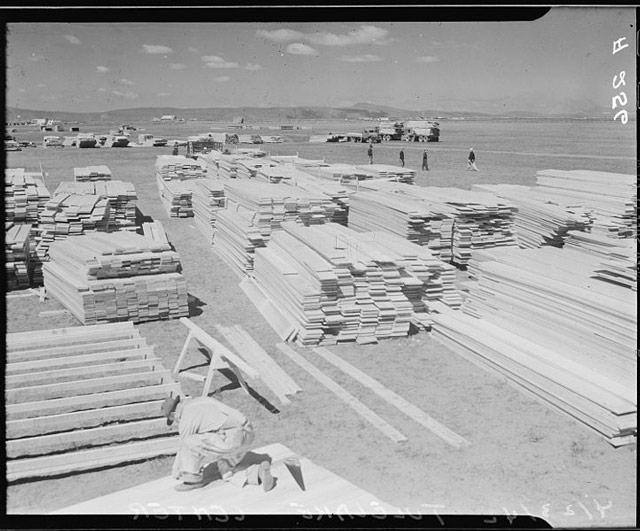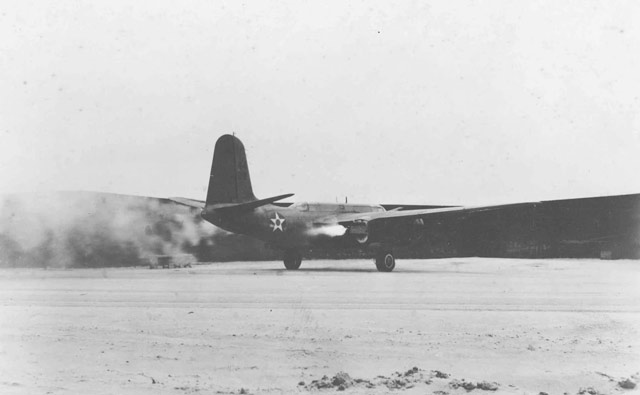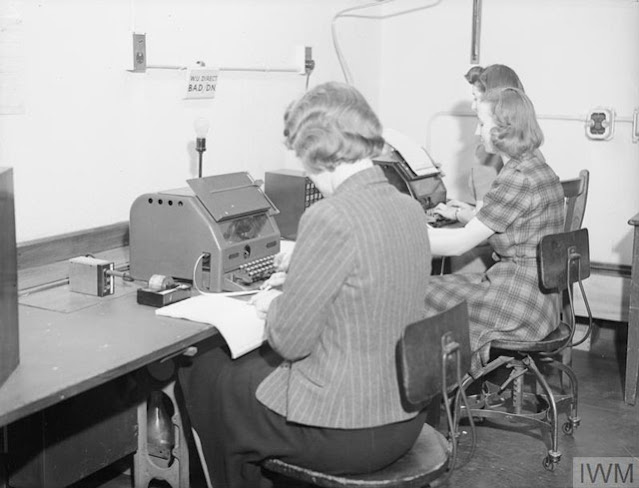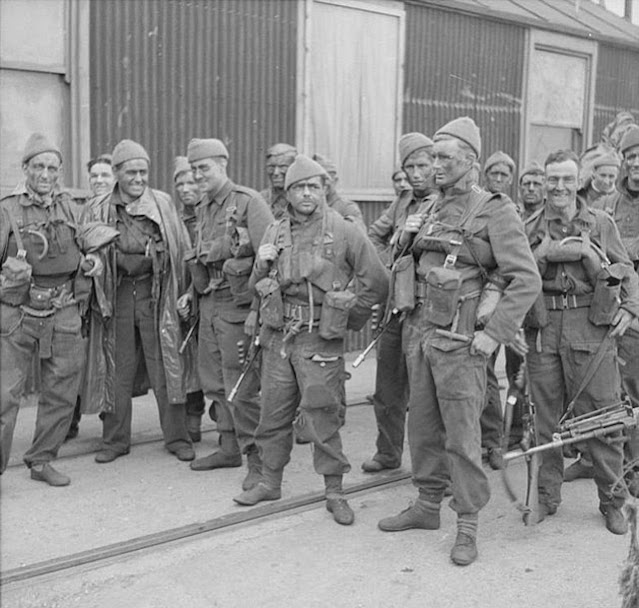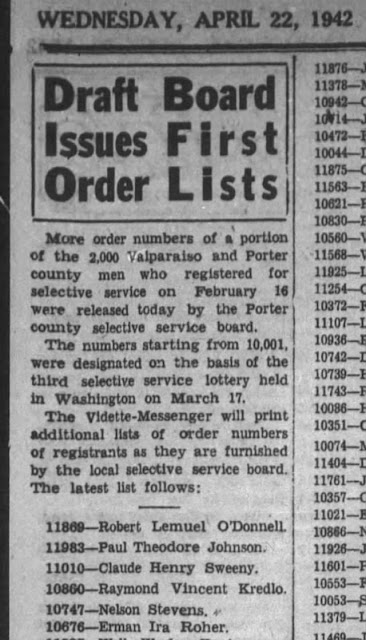Saturday 25 April 1942
 |
| German soldiers escort a column of Jewish residents of Würzburg to a waiting train for their evacuation to the extermination camp at Sobibor on 25 April 1942. Photo: State Archives Würzburg. |
Battle of the Pacific: The Japanese attempt to bomb Darwin in northern Australia again on 25 April 1942, but they get a hot reception. The 49th Pursuit Group (Interceptor) of Fifth Air Force is now at full strength there. Flying Curtiss P-40 Warhawks, the Group shoots down 10 Japanese bombers and 3 Zero fighters at no loss to themselves. Gradually, the Allied air defenses in the region are firming and are much more effective than just a few weeks earlier.
US Navy submarine USS Spearfish torpedoes 7296-ton Japanese freighter (requisitioned by the Navy) Toba Maru northwest of Luzon, Philippines. The ship's crew manages to beach the ship 10 km west of Cape Candon, Luzon. It is later refloated and towed to Kirun for repair.
US Navy submarine Pickerell (SS-177), on her fourth wartime patrol, torpedoes and damages Japanese hospital ship Takasugo Maru in Manipa Strait, Malay Archipelago (Indonesia).
Aircraft of unknown nationality damage Japanese transport No. 2 Nankai Maru near Shortland Island in the western Solomons.
Battle of the Indian Ocean: The British continue bugging out from positions they never expected to be in any jeopardy. The Bush Warfare School at Maymyo is forced today to leave for Sagaing and is activated for combat there. While the Chinese 200th Division has recaptured Loilem and neared Hopong, the Japanese continue advancing around them and are on the verge of occupying all of the Shan States. This would open a path to northern Burma via Bhamo and Myitkyina.
 |
| The lead story in the 25 April 1942 Saturday Evening Post is "Japan's Islands of Mystery." |
General Alexander observes the Japanese advancing on Mandalay and orders all Allied troops to withdraw to the north of that city. This means the Chinese must abandon their defenses at Pyawbwe, south of Mandalay. General Chang, commander of the Chinese Sixty-Sixth Army, arrives in Lashio and takes command of all Chinese troops in the area, but it does not appear the Allies can hold the city for long.
The spring thaw ("Rasputitsa") is in full swing, so not much is happening along the Eastern Front. Halder laconically notes, apparently without irony, "All quiet along the entire front. Local enemy probing on the front of the Second Army."
RAF aircraft bomb and sink German freighter Leesee off Norway.
US 770-ton freighter Wellesley catches fire and is a total loss in the Oakland Estuary, California.
POWs: A full week after French General Henri Giraud's escape from Königstein Fortress, Berlin radio finally announces it. They offer a 100,000 mark reward for information that leads to his capture. Giraud, however, already is in neutral Switzerland, which the Germans probably know from their Swiss spies. Just to make sure that everyone knows that Germany is upset about the escape, word then is put out that Giraud's relatives are being arrested. It is a nice propaganda victory for the Allies and plays out exactly as one would expect.
April 2, 1942: Doolittle Raiders Leave Port
April 3, 1942: Japanese Attack in Bataan
April 4, 1942: Luftwaffe Attacks Kronstadt
April 5, 1942: Japanese Easter Sunday Raid on Ceylon
April 6, 1942: Japanese Devastation In Bay of Bengal
April 7, 1942: Valletta, Malta, Destroyed
April 8, 1942: US Bataan Defenses Collapse
April 9, 1942: US Defeat in Bataan
April 10, 1942: The Bataan Death March
April 11, 1942: The Sea War Heats Up
April 12, 1942: Essen Raids Conclude Dismally
April 13, 1942: Convoy QP-10 Destruction
April 14, 1942: Demyansk Breakout Attempt
April 15, 1942: Sobibor Extermination Camp Opens
April 16, 1942: Oil Field Ablaze in Burma
April 17, 1942: The Disastrous Augsburg Raid
April 18, 1942: The Doolittle Raid bombs Japan
April 19, 1942: British in Burma Escape
April 20, 1942: The Operation Calendar Disaster
April 21, 1942: Germans Relieve Demyansk
2021
Obstlt. Hans-Ekkehard Bob of JG 54 shoots down a MiG-3 over Leningrad for his 40th victory. During the raid, the Luftwaffe sinks 893-ton Estonian freighter VT-510 (formerly the Vahur, seized by the USSR in 1940).
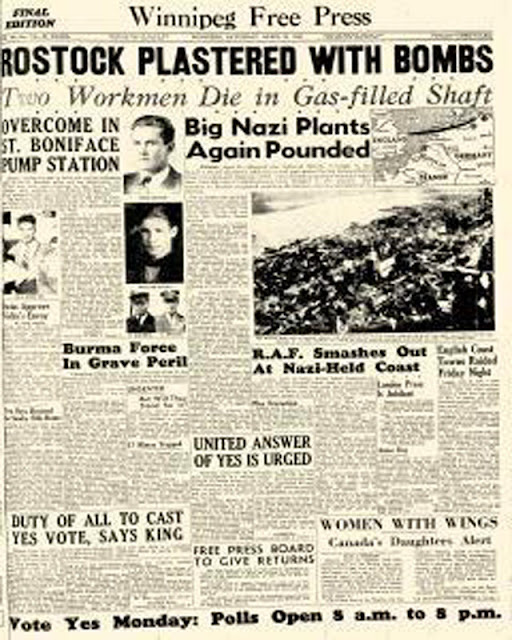 |
| As this 25 April 1942 edition of the Winnipeg Free Press shows, the RAF raids on Rostock receive a lot of press, the Luftwaffe raids on Exeter, not so much. Perhaps that is due to security concerns. |
European Air Operations: The Luftwaffe "Baedeker Raids" continue. After two nights of attacking Exeter with mediocre results, tonight's new Luftwaffe target is Bath, which has been largely untouched so far in the war. This raid by 80 aircraft is much more successful than the Exeter raids, causing widespread damage and 400 casualties. Many citizens don't bother seeking cover because previous Luftwaffe missions have overflown the city on the way to the aircraft factories at Bristol. However, the German pathfinders drop their flares over Bath and that leads to a night of horror. The first bombs fall just before 23:00 and the raid lasts for two hours. As is their custom, the Luftwaffe bombers then return a few hours later after refueling and rearming in France, causing more damage and catching people by surprise again after the "all clear" has sounded. Many historic buildings are destroyed among the roughly 19,000 buildings hit in some way during the Bath raids. The Luftwaffe loses four aircraft in this raid.
RAF Bomber Command raids the north German port of Rostock again with 128 bombers. As they have on previous nights, the bombers split up, with 110 heading downtown and 18 to the Heinkel factory on the outskirts of town. For the first time, some hits are scored on the Heinkel factory by Manchester bombers of RAF No. 156 Squadron under the command of Wing Commander Guy Gibson. No planes are lost on this mission.
In a subsidiary attack, half a dozen Stirling bombers attack the Skoda armaments factory in Pilsen, Czechoslovakia. They lose one bomber. Another 32 bombers do a "milk run" to Dunkirk, while 2 Blenheim intruders attack targets inland and 5 bombers drop leaflets over France.
Johannes Seifert of I./JG-26, a top Luftwaffe ace on his way to 57 aerial victories, shoots down a Spitfire five miles northwest of Berck-sur-Mer, killing the pilot.
Johannes Seifert of I./JG-26, a top Luftwaffe ace on his way to 57 aerial victories, shoots down a Spitfire five miles northwest of Berck-sur-Mer, killing the pilot.
Battle of the Atlantic: U-108 (KrvKpt. Klaus Scholtz), on its seventh patrol out of Lorient, torpedoes and sinks 3849-ton British (formerly Finnish) freighter Modesta in the mid-Atlantic 110 miles northwest of Bermuda. There are 18 deaths and 23 survivors, who are rescued by Belgian freighter Belgian Airman.
RAF aircraft bomb and sink German freighter Leesee off Norway.
US 770-ton freighter Wellesley catches fire and is a total loss in the Oakland Estuary, California.
British 248-ton trawler HMT Daisy is lost in a storm in the Clyde. Boom defense vessel HMT Chorley also springs a leak and is lost, with three dead.
 |
| Finnish soldier and dog in position near Kiestinki, 25 April 1942. Photographer: Erkki Viitasalo. SA-Kuva. |
Battle of the Mediterranean: The Axis continues to bomb Malta with overpowering numbers. An estimated 246 enemy raiders make 19 attacks today, dropping 1000 bombs totaling 317,486kg. The bombers target the Pembroke area, including No. 45 General Hospital at St. Patrick's and No. 39 General Hospital at St. Andrews. There are reports by some witnesses (including Lieutenant George Carroll, a bomb disposal officer being treated at No. 45 General Hospital) that the planes are specifically targeting the hospitals.
 |
| Anzac Day celebration in Jerusalem, 25 April 1942 (Library of Congress matpc 21260). |
The entire tale of Giraud's escape from an "inescapable" prison and subsequent events, however, is very odd. Tellingly, after Giraud brazenly returns to Vichy France, the Germans do not compel Premier Petain to return him to Germany for punishment despite German domination of the French state. Getting nowhere with Petain, Giraud quickly goes over to the Free French side despite his well-known antipathy for the British. He receives prominent posts but becomes embroiled in disagreements with Charles de Gaulle about strategy and finally is dismissed from all commands.
Giraud's escape ultimately proves only to be a major distraction for the Allies - which may have been the intent all along. On its face, Giraud's tale of scaling down a prison wall using bedclothes seems like a bit of brilliant derring-do, and that is how the history books treat it. However, while there is no proof of German complicity, the "escape" has the hallmarks of a Gestapo operation.
US Military: US troops arrive in New Caledonia. Its capital of Nouméa quickly becomes the main South Pacific Fleet base of the United States Navy in the region. About 50,000 US troops eventually are garrisoned on New Caledonia.
Holocaust: The Würzburg Gestapo orders about 800 Jews from 19 different sub-districts and three different counties (a total of 80 different communities) to assemble in Platz’schen-Garten. Another group from Würzburg itself also is ordered to appear. They are searched and relieved of any valuables, including all currency. At about 15:00, the group boards a train and leaves on an "evacuation." This is the third deportation from Würzburg to the East. Their initial destination is Krasnystaw in the Lublin district of Poland, where they are marched on foot to Krasniczin. Eventually, the survivors are taken to Sobibor on 6 July 1942.
 |
| Jews being marched down Schweinfurter Strasse in Würzburg to a waiting train (Photo: State Archives Würzburg). |
At Auschwitz, 100 Poles from Cracow are registered. This particular group was arrested on 16 April 1942 while at the Café of Artists and includes four painters (Tadeusz Mróz, Ludwik Puget, Tadeusz Różycki, and Karol Siwek). All four are shot on 27 May 1942.
British Homefront: Princess Elizabeth, 16, registers for war service. She eventually will serve in a motor pool.
American Homefront: "Moonlight Cocktail" by Glenn Miller and His Orchestra with Ray Eberle and the Modernaires is the No. 1 song on the Billboard Charts today for the ninth week in a row. It will spend one more week at No. 1 and be the number two record for 1942 after Bing Crosby's "White Christmas."
Future History: Jon Llewellyn Kyl is born in Oakland, Nebraska. He becomes a prominent politician in Arizona, serving in its House delegation from 1987-1995 and later as a senator from 1995-2013 and again in 2018.
British Homefront: Princess Elizabeth, 16, registers for war service. She eventually will serve in a motor pool.
 |
| Two Japanese-Americans play a game while waiting on 25 April 1942 to be picked up by the War Relocation Authority (WRA) in San Francisco, California (Dorothea Lange). |
Future History: Jon Llewellyn Kyl is born in Oakland, Nebraska. He becomes a prominent politician in Arizona, serving in its House delegation from 1987-1995 and later as a senator from 1995-2013 and again in 2018.
Katsuji Adachi is born in Tennōji-ku, Osaka, Japan. As "Mr. Hito," Adachi becomes a famous wrestler, best known as the tag-team partner of American/Canadian wrestler "Mr. Moto" (McRonald Kamaka).
 |
| Medal of Honor winner Edward H. "Butch" O'Hare receives a ticker-tape homecoming parade along with his wife Rita in his native St. Louis, Missouri, 25 April 1942 (St. Louis Dispatch). |
April 1942
April 1, 1942: Convoys Come to the USAApril 2, 1942: Doolittle Raiders Leave Port
April 3, 1942: Japanese Attack in Bataan
April 4, 1942: Luftwaffe Attacks Kronstadt
April 5, 1942: Japanese Easter Sunday Raid on Ceylon
April 6, 1942: Japanese Devastation In Bay of Bengal
April 7, 1942: Valletta, Malta, Destroyed
April 8, 1942: US Bataan Defenses Collapse
April 9, 1942: US Defeat in Bataan
April 10, 1942: The Bataan Death March
April 11, 1942: The Sea War Heats Up
April 12, 1942: Essen Raids Conclude Dismally
April 13, 1942: Convoy QP-10 Destruction
April 14, 1942: Demyansk Breakout Attempt
April 15, 1942: Sobibor Extermination Camp Opens
April 16, 1942: Oil Field Ablaze in Burma
April 17, 1942: The Disastrous Augsburg Raid
April 18, 1942: The Doolittle Raid bombs Japan
April 19, 1942: British in Burma Escape
April 20, 1942: The Operation Calendar Disaster
April 21, 1942: Germans Relieve Demyansk

